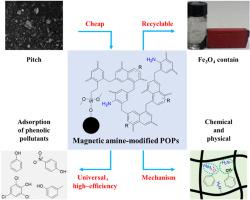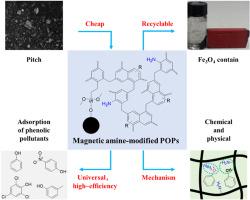Magnetic amine–modified pitch–based hypercrosslinked polymers for high–efficiency adsorption of phenolic pollutants
IF 4.5
2区 化学
Q2 POLYMER SCIENCE
引用次数: 0
Abstract
Porous organic polymers (POPs) are promising materials for the adsorption of phenolic pollutants in wastewater due to their advantages including high surface area, tunable pore structure, easy to surface chemical functionalities, good physicochemical stability, etc. However, understanding the adsorption mechanism and realizing POPs with combined properties including low–cost, recyclable and high–efficiency remain challenges. In this work, four magnetic amine–modified pitch–based hypercrosslinked polymers (MAPHCPs) with different aniline (PA) content, PP, PP0.8PA0.2, PP0.6PA0.4 and PP0.4PA0.6, were synthesized and studied. All MAPHCPs demonstrated good thermostability and magnetic recyclability. With increasing PA content, the specific surface area decreased, while the pore sizes were similar. However, the calculated maximum adsorption capacity of the four phenolic pollutants onto PP0.4PA0.6 was between 47 % and 129 % higher than that of PP. The theoretical analysis and experimental results suggest that the acid-base interaction is the primary cause, with the dipolar and hydrogen bonding interactions as secondary causes for these improvements. This work not only demonstrates an approach for the preparation of low-cost, recyclable and high–efficiency POPs for the adsorption of phenolic pollutants, but also clarifies the combined mechanisms of chemical adsorption and physical adsorption.


磁性胺改性沥青基高交联聚合物对酚类污染物的高效吸附
多孔有机聚合物(POPs)具有比表面积大、孔结构可调、表面化学功能易于实现、物理化学稳定性好等优点,是吸附废水中酚类污染物的理想材料。然而,了解持久性有机污染物的吸附机理并实现低成本、可回收和高效的综合性能仍然是一个挑战。本文合成并研究了苯胺(PA)含量不同的PP、PP0.8PA0.2、PP0.6PA0.4和PP0.4PA0.6四种磁胺改性沥青基超交联聚合物(mapcps)。所有mapcps均表现出良好的热稳定性和磁性可回收性。随着PA含量的增加,比表面积减小,而孔径基本不变。然而,计算出的4种酚类污染物在PP0.4PA0.6上的最大吸附量比PP高47% ~ 129%。理论分析和实验结果表明,酸碱相互作用是主要原因,偶极和氢键相互作用是次要原因。本研究不仅为制备低成本、可回收、高效的吸附酚类污染物的持久性有机污染物提供了途径,而且阐明了化学吸附与物理吸附相结合的机理。
本文章由计算机程序翻译,如有差异,请以英文原文为准。
求助全文
约1分钟内获得全文
求助全文
来源期刊

Polymer
化学-高分子科学
CiteScore
7.90
自引率
8.70%
发文量
959
审稿时长
32 days
期刊介绍:
Polymer is an interdisciplinary journal dedicated to publishing innovative and significant advances in Polymer Physics, Chemistry and Technology. We welcome submissions on polymer hybrids, nanocomposites, characterisation and self-assembly. Polymer also publishes work on the technological application of polymers in energy and optoelectronics.
The main scope is covered but not limited to the following core areas:
Polymer Materials
Nanocomposites and hybrid nanomaterials
Polymer blends, films, fibres, networks and porous materials
Physical Characterization
Characterisation, modelling and simulation* of molecular and materials properties in bulk, solution, and thin films
Polymer Engineering
Advanced multiscale processing methods
Polymer Synthesis, Modification and Self-assembly
Including designer polymer architectures, mechanisms and kinetics, and supramolecular polymerization
Technological Applications
Polymers for energy generation and storage
Polymer membranes for separation technology
Polymers for opto- and microelectronics.
 求助内容:
求助内容: 应助结果提醒方式:
应助结果提醒方式:


